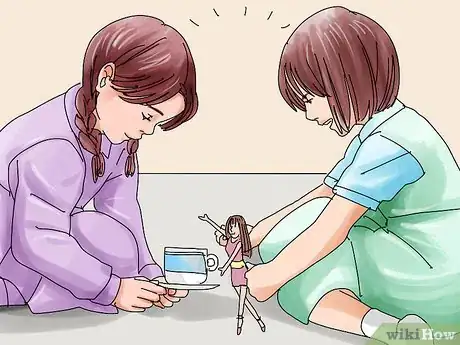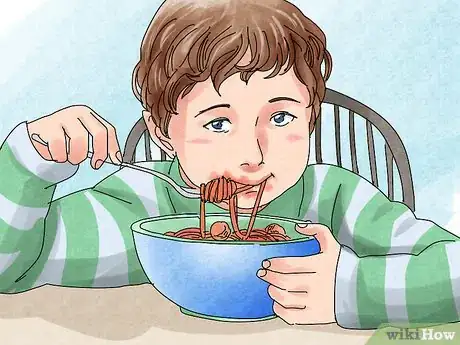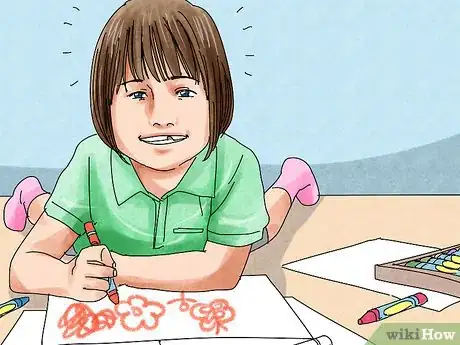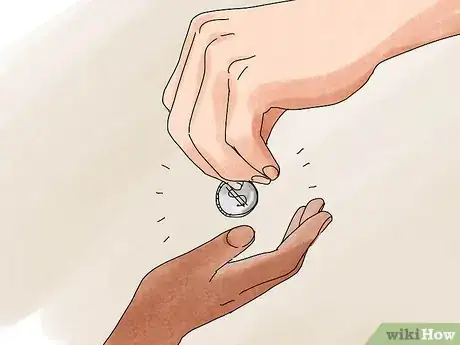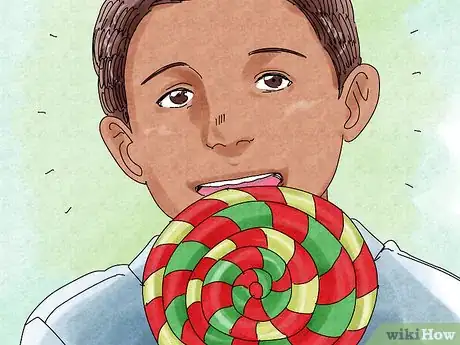This article was co-authored by Wits End Parenting. Wits End Parenting is a parent-coaching practice based in Berkeley, California specializing in strong-willed, “spirited” children with impulsivity, emotional volatility, difficulty “listening,” defiance, and aggression. Wits End Parenting's counselors incorporate positive discipline that is tailored to each child’s temperament while also providing long-term results, freeing parents from the need to continually re-invent their discipline strategies.
This article has been viewed 68,907 times.
Rewarding your child can help motivate them and encourage good behavior, and there are actually all kinds of different ways you can go about it. Not all of them involve giving your child material things either, although tangible rewards definitely have their place too! Below we’ve put together a list of different ways you can show your child you appreciate their good behavior, plus some tips on how to make your rewards as effective as possible.
Steps
Using Social Rewards
-
1Give your child affection as a reward. Using affection as a reward can be an effective way to let your child know you approve of their behavior. You may give your child a high five, a pat on the back, arm or shoulder, or a big smile. You can also display other forms of affection, like hugs or kisses.[1]
- The benefit of using affection as a reward is that it is free and immediate, so you can use it as a reward as soon as your child does something good. Displaying affection toward your child can also help them get used to displaying affection in public and get comfortable with being social and affectionate with others.
-
2Spend extra, quality time with your child. You can also reward you child’s good behavior by spending extra time with your child. This could be an additional five to ten minutes of reading time before bed or extra time together after school doing an activity your child enjoys, such as playing a certain board game. Using quality time as a form of reward can also allow you to create stronger social bonds with your child.[2] [3]
- For example, your child may love to spend time with you in the kitchen. You may then reward their good behavior by allowing them to help you prepare a batch of cookies or add decorations to a cake. This will allow you both to spend quality time together and create something you can both enjoy.
Advertisement -
3Reward your child with a special outing or activity. Maybe your child enjoys going to a park near your home or maybe your child can not get enough of a play zone at the mall. If you child is on good behavior, you may reward them with a special outing to their favorite place or the opportunity to do a favorite activity.[4] [5]
- For example, maybe your child enjoys going to the movies. You may then reward their good behavior by taking them to the latest movie for kids, a movie date for just the two of you.
-
4Allow your child to spend time with their friends as a reward. Your child may also respond well to getting free time as a reward, where they can hang out with their friends. This is a good reward for older children, as it will allow your child to connect socially with others.[6] [7]
- You may set a time limit for this reward, such as giving your child one extra hour of play time at a friend’s house or allow your child to sleep over for one night at a friend’s house. This way, you still have control of the reward but your child is still able to benefit from it.
Giving Out Material Rewards
-
1Allow your child to choose a special meal. You can reward your child using a material reward like food. But, rather than simply give your child their favorite food, you may give them the opportunity to choose a special meal that you can enjoy together. This could be a favorite meal of homemade spaghetti or a takeout meal. Your child will enjoy the feeling of responsibility that comes with choosing a special meal.[8]
- Keep in mind there is some debate around using food as a form of material praise. Some child specialist argue that using food to praise your child can lead to an unhealthy relationship with food in the future and undermine your child’s healthy eating habits. Allowing your child to have a special, unhealthy meal can lead to confusion around when eating unhealthy food is appropriate. Your child may associate unhealthy food with good behavior and positive self-esteem.[9]
- Though you can use food as a form of reward, try to use it sparingly. Often, social rewards and verbal praise can be more effective and healthy for your child than material rewards, like food.
-
2Give your child useful items as rewards. Material items can be used as rewards but you should be careful not to simply give your child toys. Instead, you may go for practical items like school supplies or items for your child's room. This way, your child can still reap the satisfaction of a material reward and get use out of it.
- You may give your child pencils, pens, and notepads that they can use in school. Or, you may give your child stickers to decorate their notebooks and their lunch box. Your child may also have specific school supplies in mind, which you can then buy for them as a reward for good behavior.
-
3Reward your child with items that relate to their favorite hobby or activity. You should also try to go for material items that feel specific to your child’s interests. Think about material items that complement your child’s favorite activity or hobby. This will ensure your child gets use out of the material item and does not see it as just another toy or material item.[10]
- For example, maybe your child is really into a certain video game. You may then get your child a video game made by the same company or designer, or a doll version of their favorite video game hero. If your child is into other hobbies, like painting, you may get them a set of paint brushes or a new canvas.
-
4Consider giving your child an allowance for good behavior. An allowance is a good option for children once they reach four or five, as at this age children tend to be more aware of wants and needs. Giving your child an allowance is a good way to teach your child the value of money and how be responsible with money.[11]
- You may start the allowance by giving your child a small amount of money based on how old they are, such as $1 for each year old. So, a seven year old would get $7 in allowance. The idea is to give your child enough allowance to get one or two things they want but not too much, as you want your child to decide what to spend their money on and to spend it wisely.
- Start by giving your child real cash so they can hold the physical money and learn how to count it. Then, as they get older and hit adolescence, you can give them virtual money, which they can manage through an allowance App on their phone or on the computer. Once your child is a teenager, they may be ready for getting their allowance through a bank account.
Using Verbal Praise
-
1Encourage your child to self-evaluate and self-assess. Rather than use standard words of praise like “Great job!”, “Good boy/good girl!” or “That’s right!”, you should try to get your child to evaluate themselves and their skills when you praise them. You may say, “You look like you enjoyed that!”, “I’m happy you did that, you look pleased with yourself!” or, “Did it feel good to do that?” Doing this will encourage your child to think about their own actions and decisions, rather than constantly seek your approval or validation. This will allow your child to feel empowered and see good behavior as a positive way to act.[12]
- You may also ask your child questions as a form of praise to get them to self-evaluate. For example, you may ask, “How do you like your painting?” or “Are you happy with how that piece fits into the game?”
- You should also try to encourage your child to reflect on their decisions and choices. You may ask, “How do you feel about the picture you drew?” or “Did you enjoy telling that story in class?” This will help to build your child’s self-esteem and strengthen your relationship with them.
-
2Use “I” statements when you praise your child. You should also try to always use “I” statements when you give your child verbal praise, as this will show your child you appreciate their actions. It will also make your praise specific and singular to your child. Your child can model their behavior on yours and also learn how to use “I” statements for themselves.[13]
- For example, you may complement your child’s behavior by saying, “I love the colors you picked!” or “I really enjoyed how you performed that dance!”. Do this instead of saying “what a good dancer you are!” or “gosh, you’re a great dancer”. “I” statements will make your praise more specific to your child and show your child how you express your feelings and thoughts in a positive way.
- You should also avoid generalizing statements like, “Good girl for sharing your pencils!” or “You are a good boy for staying quiet in class today.” Instead, you can say, “Thanks for sharing with your friend today, I think he appreciated it.”
-
3Focus on praising the behavior, not the child. You should never say your child is “bad” or “good”, only that their behavior is “bad” or “good”. This will ensure your child does not associate your praise with themselves overall, and only to their behavior. Be specific and tell your child exactly how and why her behavior was good.[14]
- For example, your child may have made you a birthday card. Rather than say, “What a great card you have made me!”, you should be specific and tell your child what elements you liked in the card. Maybe you complement their choice of color, their penmanship, or their sweet message inside the card.
Rewarding Your Child Effectively
-
1Use a rewards chart. Many parents use a rewards chart to let their child know how well they are behaving. Check off good behavior with smiley faces or plus signs. You may use stickers to track your child’s behavior, with gold stars for good behavior. Or, you may allow your child to create their own chart to then post on the refrigerator or the wall. This will allow your child to judge their own behavior on a daily basis.
- There has been some criticism of the use of a rewards chart to track a child’s behavior. Some studies have shown that offering up tangible rewards for behavior can actually make your child view good behavior as transactional. Your child may only be motivated to do well for a reward and get upset when they are not rewarded every time they act.[15]
-
2Use different forms of praise. You should try to use a variety of rewards for your child’s behavior, as kids get bored easily. If you use the same rewards every time, the reward may lose its power over time. You may give your child verbal praise for small acts of good behavior and then social or material rewards for larger acts of good behavior.[16]
- If you have multiple children in one household, you should also use different rewards for each child. No two children are alike and each child may respond differently to different rewards. Try to fit the reward to the child’s personality and demeanor.
-
3Give younger children more immediate rewards. Younger children respond well to smaller, more immediate rewards, such as verbal praise or a small material item, like a sticker or a small toy. Many children can start to understand the power of rewards by the age of three. You should focus on smaller, immediate rewards first and then shift your approach as your child gets older.
- Older children may respond better to more accumulative rewards, such as an allowance or extra time doing something they enjoy. Adolescents and teenagers also start to see the value in social rewards, such as quality time with friends or quality time with parents.
-
4Set realistic, specific behavioral goals for your child. You should also encourage your child to continue to display good behavior by establishing behavioral goals that are realistic and specific to your child. This will help your child to learn the value of good behavior and feel as though they can meet your expectations.
- For example, maybe you expect your child to help set the table for dinner every night. You may model this behavior by helping them set the table at first and then over time, give them the responsibility to do it on their own. You should then praise your child when they set the table without you asking, reinforcing their good behavior. This will allow you to set your child up to succeed and then praise them when they fulfill your reasonable expectations.
Expert Q&A
-
QuestionHow do you reward children without spoiling them?
 Wits End ParentingWits End Parenting is a parent-coaching practice based in Berkeley, California specializing in strong-willed, “spirited” children with impulsivity, emotional volatility, difficulty “listening,” defiance, and aggression. Wits End Parenting's counselors incorporate positive discipline that is tailored to each child’s temperament while also providing long-term results, freeing parents from the need to continually re-invent their discipline strategies.
Wits End ParentingWits End Parenting is a parent-coaching practice based in Berkeley, California specializing in strong-willed, “spirited” children with impulsivity, emotional volatility, difficulty “listening,” defiance, and aggression. Wits End Parenting's counselors incorporate positive discipline that is tailored to each child’s temperament while also providing long-term results, freeing parents from the need to continually re-invent their discipline strategies.
Parenting Specialists Reserve rewards for exceptional behavior, not expected behavior. If you rely entirely on rewards to motivate your child to complete an activity like getting dressed or participating in household activities, it tells them that you don't expect them to normally do those things. Also, use connection as a reward. Don't just give your child objects or food. For example, a young child would consider 5 extra minutes' snuggle time as a reward, while an older child might love 10 minutes of basketball with you.
Reserve rewards for exceptional behavior, not expected behavior. If you rely entirely on rewards to motivate your child to complete an activity like getting dressed or participating in household activities, it tells them that you don't expect them to normally do those things. Also, use connection as a reward. Don't just give your child objects or food. For example, a young child would consider 5 extra minutes' snuggle time as a reward, while an older child might love 10 minutes of basketball with you. -
QuestionHow should I reward my child?
 Wits End ParentingWits End Parenting is a parent-coaching practice based in Berkeley, California specializing in strong-willed, “spirited” children with impulsivity, emotional volatility, difficulty “listening,” defiance, and aggression. Wits End Parenting's counselors incorporate positive discipline that is tailored to each child’s temperament while also providing long-term results, freeing parents from the need to continually re-invent their discipline strategies.
Wits End ParentingWits End Parenting is a parent-coaching practice based in Berkeley, California specializing in strong-willed, “spirited” children with impulsivity, emotional volatility, difficulty “listening,” defiance, and aggression. Wits End Parenting's counselors incorporate positive discipline that is tailored to each child’s temperament while also providing long-term results, freeing parents from the need to continually re-invent their discipline strategies.
Parenting Specialists Determine whether your child is motivated by rewards. Many strong-willed or "oppositional" kids are not motivated by rewards. In that case, you have to find out what does motivate your child, based on their unique temperament. If your child does respond to rewards, it's important to raise your expectations periodically so that it becomes harder to earn the same reward. This shows them that it's important to develop and grow.
Determine whether your child is motivated by rewards. Many strong-willed or "oppositional" kids are not motivated by rewards. In that case, you have to find out what does motivate your child, based on their unique temperament. If your child does respond to rewards, it's important to raise your expectations periodically so that it becomes harder to earn the same reward. This shows them that it's important to develop and grow.
References
- ↑ http://www.cdc.gov/parents/essentials/consequences/rewards.html
- ↑ http://www.cdc.gov/parents/essentials/consequences/rewards.html
- ↑ https://childdevelopmentinfo.com/how-to-be-a-parent/parenting/rewards/
- ↑ http://www.cdc.gov/parents/essentials/consequences/rewards.html
- ↑ https://childdevelopmentinfo.com/how-to-be-a-parent/parenting/rewards/
- ↑ http://www.cdc.gov/parents/essentials/consequences/rewards.html
- ↑ https://childdevelopmentinfo.com/how-to-be-a-parent/parenting/rewards/
- ↑ https://childdevelopmentinfo.com/how-to-be-a-parent/parenting/rewards/
- ↑ https://www.urmc.rochester.edu/encyclopedia/content.aspx?ContentTypeID=160&ContentID=32
- ↑ https://childdevelopmentinfo.com/how-to-be-a-parent/parenting/rewards/
- ↑ https://money.com/downside-treating-kids-for-good-behavior/
- ↑ http://www.naturalchild.org/robin_grille/rewards_praise.html
- ↑ http://www.naturalchild.org/robin_grille/rewards_praise.html
- ↑ http://www.naturalchild.org/robin_grille/rewards_praise.html
- ↑ http://www.theatlantic.com/health/archive/2016/02/perils-of-sticker-charts/470160/
- ↑ http://www.cdc.gov/parents/essentials/consequences/rewards.html



